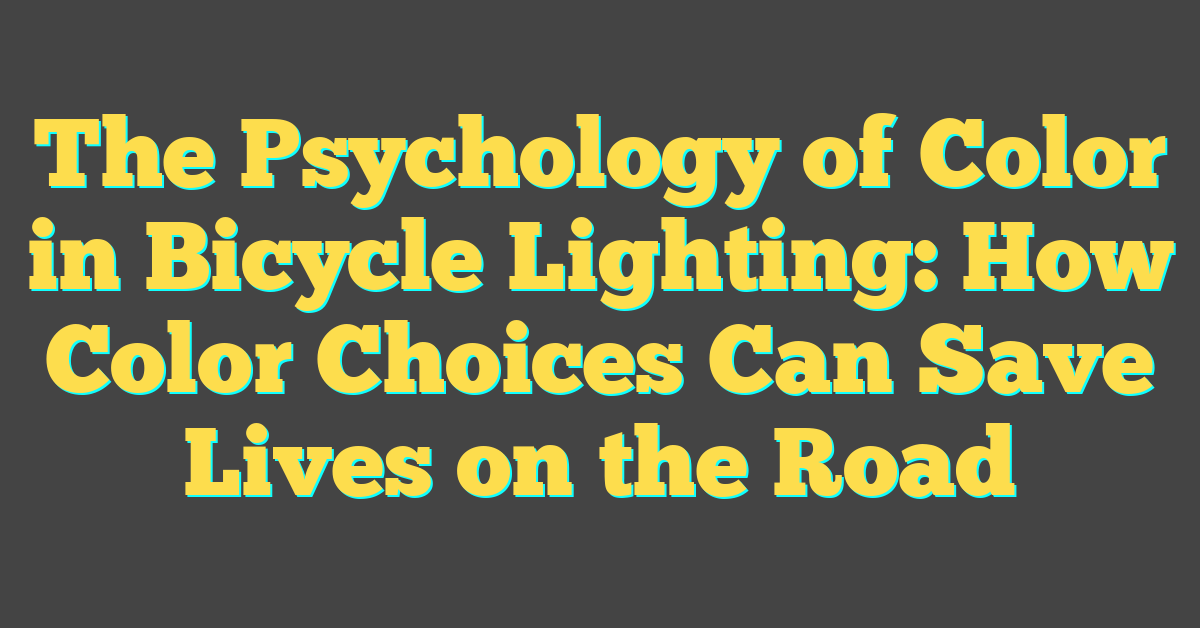When I think about cycling, safety is always at the top of my mind. But have you ever considered how the colors of your bike lights influence not just visibility but also how others perceive you on the road? It’s fascinating how something as simple as color can shape reactions, moods, and even decision-making in split-second moments.

Colors aren’t just for aesthetics—they carry psychological weight. A bright red taillight signals urgency, while a cool white headlight feels crisp and focused. These choices aren’t random; they tap into our subconscious, affecting how drivers, pedestrians, and fellow cyclists respond to us. Understanding this connection can make a huge difference in how we ride and how safe we feel.
I’ve always been curious about the subtle ways color impacts our world, and bicycle lighting is no exception. Let’s dive into this blend of psychology and practicality to uncover what makes it so powerful.
Understanding The Psychology Of Color
Colors do more than make bike lights look appealing; they influence how people perceive and respond to others on the road. As someone who’s spent years riding and tinkering with bikes, I find it fascinating how something as simple as color can significantly enhance safety and communication.
The Science Behind Color Perception
Colors are detected through cone cells in our eyes, with the brain processing these signals to interpret hues. Red, for example, has a long wavelength, making it easier to spot in low-light conditions. This is why red dominates as the color for rear bike lights, signaling caution and stopping intent. Blue, with its shorter wavelength, attracts attention but isn’t as effective for distance visibility as red or white.
Studies show that white light mimics daylight, helping cyclists see clearly and allowing others to gauge a rider’s position accurately. For side visibility, amber is effective due to its ability to stand out without overwhelming. As an avid tinkerer with bike lights, I’ve used these principles to customize my setups, ensuring optimal visibility.
Emotional Impact Of Colors
Colors evoke different psychological effects, often altering behaviors. Red triggers urgency and caution, prompting drivers and pedestrians to slow down or steer clear. White, associated with clarity and precision, gives a sense of trust and reliability. Blue might inspire calmness but can also feel less urgent, making it less ideal for critical safety cues.
Amber, on the other hand, balances visibility and emotion, creating a warm yet attention-grabbing signal. Incorporating these shades into my lighting designs has taught me how crucial emotional responses are in creating safer interactions between cyclists and others.
Importance Of Bicycle Lighting
Bicycle lighting isn’t just about aesthetics—it’s vital for safety and visibility. It ensures cyclists are noticed and helps others on the road predict their movements.
Enhancing Safety And Visibility
Good lighting improves visibility for cyclists and makes them stand out to drivers, pedestrians, and other cyclists. I always recommend using white front lights to simulate daylight and red rear lights for signaling, as they’re universally recognized. During poor lighting conditions like fog or nighttime, bright LED lights with high lumens perform best. Flashing modes on lights grab attention, but steady beams help with depth perception, creating a balance. Reflective materials on bikes or gear complement lighting by increasing visibility from different angles.
Legal Regulations And Standards
Regulations establish minimum lighting requirements to keep cyclists safe. For instance, in the US, most states mandate a white light visible from 500 feet in front and a red rear light visible from at least 200 feet at night. Many regions also require reflectors on pedals or wheels for added visibility. I always advocate ensuring bike lights meet ANSI FL-1 standards, which certify brightness and runtime accuracy. Checking local laws before riding is important, particularly when cycling across state or country borders, as standards can vary.
Role Of Color In Bicycle Lighting
Color plays a vital role in bicycle lighting, directly affecting visibility, safety, and communication. As someone passionate about both cycling and lighting, I’ve spent countless hours exploring how colors influence rider interactions and perception on the road.
Color Choices For Day And Night Riding
Choosing the right colors for bike lights depends on the time of day. During daylight, brighter colors like white and amber are more visible against natural light. White front lights cut through bright surroundings, improving visibility for drivers and pedestrians. Amber lights, often used for turn signals or side markers, stand out in urban environments filled with visual distractions.
At night, red and white dominate for practical reasons. Rear red lights, like those seen on cars, are nearly universal for signaling a cyclist’s presence. Their wavelengths travel well through darkness and alert following traffic. White front lights illuminate the path ahead while reflecting off road signs and obstacles for better navigation. Using these colors together ensures you’re both seen and understood on the road, creating a predictable visual language.
Effectiveness Of Color In Communicating Signals
Colors on bike lights also act as signals, conveying intentions to others. Red indicates caution or stopping, making it effective for rear lights and braking indicators. For instance, a flashing red rear light grabs attention, especially in busy or dimly lit conditions, while steady red conveys your consistent location on the road.
« Solar-Powered Bike Lights: Are They Worth It? Pros, Cons, and Key Features You Need to Know
How to Photograph Your Bike at Night with Proper Lighting: Expert Tips for Stunning Shots »
Amber lights are ideal for communication, being easily recognizable for signaling turns or changes in direction. White lights carry their own psychological weight, symbolizing clarity and trust. For this reason, they’re used as front lights to help riders appear more predictable and approachable to oncoming traffic. Selecting the right combination of colors and flashing patterns enhances both your visibility and interaction with those around you.
Popular Color Options In Bicycle Lighting
As someone passionate about bikes and lighting, I’ve noticed how certain colors dominate bicycle lights for their safety and practicality. The right color choice can enhance visibility, communicate intent, and even add a touch of creativity to your ride.
Red: Warning And Alert
Red lights are essential for rear placement, where they act as a universal alert signal. Drivers instinctively associate red with caution and stopping. Its longer wavelength makes it visible in low-light or foggy conditions, making it perfect for ensuring you’re noticed from behind. Whether steady or flashing, red lights effectively signal your presence and direction to both vehicles and pedestrians.
White: Illumination And Guidance
White lights are always my go-to for front lighting. They closely mimic natural daylight, offering clear visibility for both the rider and others on the road. I often suggest using a strong LED white light with adjustable brightness, as it provides excellent illumination for nighttime rides while ensuring approaching vehicles spot you easily. White’s neutral and trustworthy nature also makes it ideal for navigating dark streets or trails confidently.
Other Colors: Creative Applications And Visibility
Colors like amber, blue, and green are less common but offer unique advantages. Amber lights are useful for side visibility or turn signaling—it gives off a balanced brightness without being too harsh. Green and blue lights, while mostly decorative, can enhance side visibility or add a fun personal touch to your bike. I’ve seen riders use them for group rides or events where standing out is part of the experience. However, it’s important to ensure alternate colors don’t overwhelm the primary purpose of visibility and safety.
Future Trends In Bicycle Lighting Design
Bicycle lighting continues to evolve, blending advancements in technology with insights from color psychology. These trends don’t just improve visibility but redefine safety and aesthetic appeal for cyclists.
Innovations In LED Technology
LED technology offers brighter, more efficient, and versatile lighting options, transforming the way cyclists illuminate their rides. High-output LEDs now deliver exceptional brightness with minimal energy consumption, extending battery life significantly. For example, modern LEDs can achieve over 200 lumens per watt, letting cyclists ride longer without frequent recharges.
Smart LEDs are gaining traction, incorporating sensors that adjust brightness based on ambient conditions. Riding through a dimly lit street? The light intensity automatically increases for better visibility. Some systems even sync with GPS data, flashing in specific patterns during turns or at intersections.
I’ve noticed a rise in full-spectrum RGB LED designs that allow custom color settings for different scenarios. Cyclists can select bright amber for daytime riding or softer red for urban night rides. Combined with app control, these options bring personalization and functionality into one package, keeping riders visible and stylish.
Emerging Research On Color Psychology
Recent research into color psychology continues to shape lighting designs for safer road interactions. Studies emphasize that colors like red and white remain critical due to their universal recognition and emotional associations. Red still conveys urgency, making it a top choice for rear lights, while white enhances trust and directional clarity when used in front lights.
New findings are exploring less conventional hues, such as cyan or magenta, which grab attention without the overbearing intensity of traditional options. While these colors aren’t as widespread, their potential for creating distinct, eye-catching signals could pave the way for more diverse lighting solutions.
The influence of light temperature also comes into play. Cooler whites (6,000-6,500 Kelvin), resembling daylight, offer clarity in varied environments. Warmer tones, like 3,000-4,000 Kelvin, might evoke a more calming effect for close-proximity interactions. Research supports using dynamic lighting systems that automatically adjust tones for specific settings, ensuring optimal visibility and emotional resonance.
Conclusion
Exploring the psychology of color in bicycle lighting has deepened my appreciation for how something as simple as light can shape our safety and interactions on the road. The relationship between color, visibility, and emotional response is fascinating and proves that thoughtful design can make a real difference.
By combining smart lighting choices with an understanding of color psychology, we can create safer, more predictable environments for everyone. Whether it’s through traditional red and white lights or innovative RGB options, the potential to enhance cycling safety is brighter than ever.




